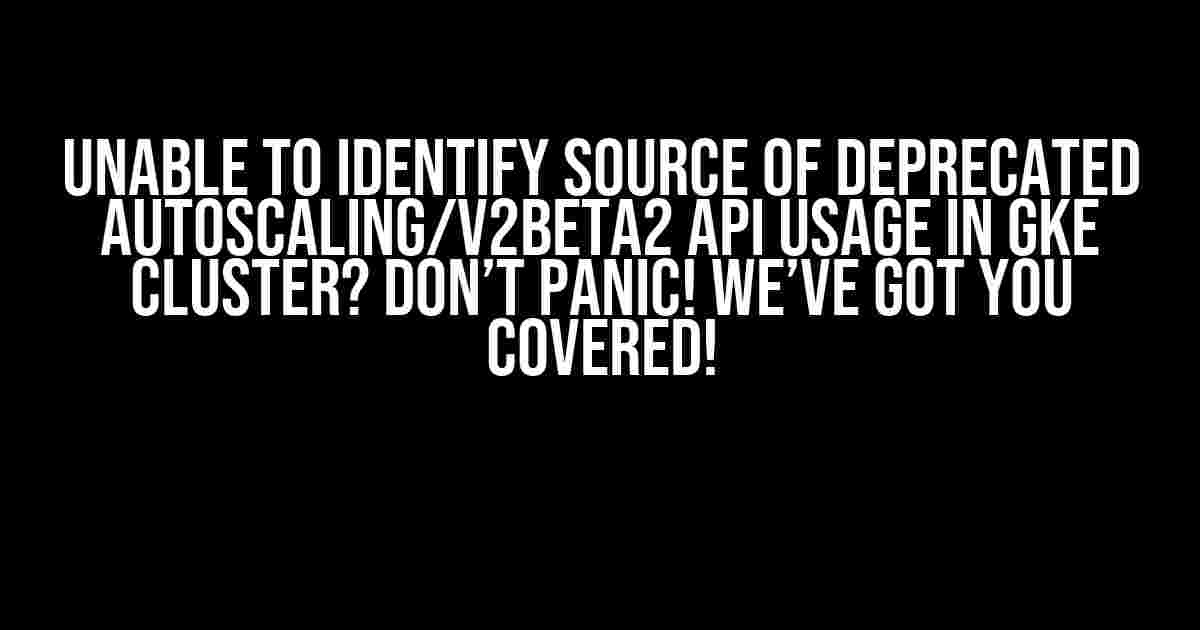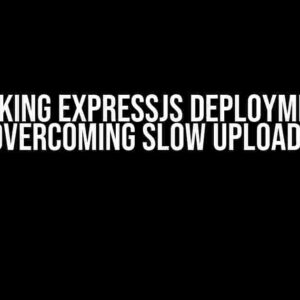If you’re reading this article, chances are you’re stuck in a frustrating situation where your Google Kubernetes Engine (GKE) cluster is throwing errors about deprecated autoscaling/v2beta2 API usage, but you have no idea where it’s coming from. Fear not, dear reader, for we’re about to embark on a troubleshooting adventure to get to the bottom of this mystery!
Understanding the Issue: What’s Autoscaling/v2beta2 Anyway?
Before we dive into the troubleshooting process, it’s essential to understand what’s causing the issue in the first place. The autoscaling/v2beta2 API is a legacy API used for horizontal pod autoscaling (HPA) in Kubernetes. It’s been deprecated since Kubernetes 1.23, and Google recommends using the newer autoscaling/v2 API instead.
apiVersion: autoscaling/v2beta2
kind: HorizontalPodAutoscaler
metadata:
name: my-hpa
spec:
scaleTargetRef:
apiVersion: apps/v1
kind: Deployment
name: my-deployment
minReplicas: 1
maxReplicas: 5
metrics:
- type: Resource
resource:
name: cpu
target:
type: Utilization
averageUtilization: 50
In the above example, the HorizontalPodAutoscaler (HPA) is using the deprecated autoscaling/v2beta2 API. This API will eventually be removed, so it’s crucial to identify and update any resources still using it.
Step 1: Check Your Cluster’s API Server Logs
To start troubleshooting, we need to investigate the API server logs to see if we can find any clues about the deprecated API usage. You can do this using the following command:
kubectl get --raw /api/v1/logs/api-server | grep " autoscaling/v2beta2"
This command will search for any logs related to the autoscaling/v2beta2 API. If you find any logs with this API version, it’s a good indication that someone or something is still using it.
Analyzing the API Server Logs
When analyzing the logs, look for any requests or responses containing the deprecated API version. Pay attention to the following fields:
verb: The HTTP verb used in the request (e.g., GET, POST, PUT, DELETE).resource: The resource being accessed (e.g., HorizontalPodAutoscaler, Deployment).apiVersion: The API version used in the request.user-agent: The client making the request (e.g., kubectl, a Kubernetes deployment).
By examining these fields, you might be able to identify the source of the deprecated API usage.
Step 2: Inspect Your Cluster’s Resources
Now that we’ve checked the API server logs, it’s time to inspect your cluster’s resources to see if any of them are using the deprecated API.
Check HorizontalPodAutoscalers
Run the following command to list all HorizontalPodAutoscalers (HPAs) in your cluster:
kubectl get hpa -A -o yaml
Look for any HPAs with the deprecated autoscaling/v2beta2 API version:
...
spec:
scaleTargetRef:
apiVersion: apps/v1
kind: Deployment
name: my-deployment
minReplicas: 1
maxReplicas: 5
metrics:
...
apiVersion: autoscaling/v2beta2
...
If you find any HPAs using the deprecated API, update them to use the newer autoscaling/v2 API:
...
spec:
scaleTargetRef:
apiVersion: apps/v1
kind: Deployment
name: my-deployment
minReplicas: 1
maxReplicas: 5
metrics:
...
apiVersion: autoscaling/v2
...
Check Deployments and ReplicaSets
Some Deployments and ReplicaSets might also be using the deprecated API. Run the following commands to list them:
kubectl get deploy -A -o yaml
kubectl get rs -A -o yaml
Inspect the output to see if any resources are using the autoscaling/v2beta2 API.
Step 3: Identify Third-Party Integrations and Custom Code
If you’ve checked your cluster’s resources and still can’t find the source of the deprecated API usage, it’s time to investigate third-party integrations and custom code.
Check Helm Charts and Kustomize Configurations
If you’re using Helm or Kustomize to manage your cluster’s resources, check their configurations for any deprecated API usage.
kubectl get helmreleases -A -o yaml
kustomize build . | yq e '.[] | select(.apiVersion == "autoscaling/v2beta2")'
Look for any Helm releases or Kustomize configurations using the deprecated API.
Review Custom Code and Scripts
If you have custom code or scripts interacting with your cluster, review them to see if they’re using the deprecated API.
grep -r "autoscaling/v2beta2" /path/to/custom/code
Check your CI/CD pipelines, scripts, and any other custom code that might be using the deprecated API.
Step 4: Update and Migrate Resources
Once you’ve identified the source of the deprecated API usage, it’s time to update and migrate your resources to use the newer autoscaling/v2 API.
Update HorizontalPodAutoscalers
Update any HPAs using the deprecated API to use the newer API:
kubectl patch hpa my-hpa -p='{"spec":{"apiVersion":"autoscaling/v2"}}'
Migrate Deployments and ReplicaSets
Migrate any Deployments and ReplicaSets using the deprecated API to use the newer API:
kubectl patch deployment my-deployment -p='{"spec":{"apiVersion":"autoscaling/v2"}}'
kubectl patch rs my-rs -p='{"spec":{"apiVersion":"autoscaling/v2"}}'
Update Third-Party Integrations and Custom Code
Update any third-party integrations or custom code using the deprecated API to use the newer API.
# Update Helm chart
helm upgrade my-chart --set autoscaling.apiVersion=autoscaling/v2
# Update Kustomize configuration
kustomize edit set autoscaling/apiVersion=autoscaling/v2
Conclusion
Congratulations! You’ve successfully identified and updated the source of the deprecated autoscaling/v2beta2 API usage in your GKE cluster. Remember to regularly review your cluster’s resources and logs to ensure you’re using the latest APIs and avoiding deprecated functionality.
By following these steps, you’ve not only resolved the issue at hand but also future-proofed your cluster for upcoming Kubernetes releases. Well done!
| Step | Description |
|---|---|
| 1 | Check API server logs for deprecated API usage |
| 2 | Inspect cluster resources (HPAs, Deployments, ReplicaSets) for deprecated API usage |
| 3 | Identify third-party integrations and custom code using deprecated API |
| 4 | Update and migrate resources to use newer autoscaling/v2 API |
Remember, staying on top of deprecated API usage is crucial for maintaining a healthy and stable Kubernetes cluster. Happy troubleshooting!
Frequently Asked Question
Get the answers to the most frequently asked questions about identifying the source of deprecated autoscaling/v2beta2 API usage in a GKE cluster.
What is the autoscaling/v2beta2 API and why is it deprecated?
The autoscaling/v2beta2 API is a deprecated version of the autoscaling API used in Google Kubernetes Engine (GKE) clusters. It’s been replaced by the autoscaling/v2 API, which provides improved functionality and performance. The v2beta2 API is deprecated and will be eventually removed, so it’s essential to identify and update any components using this API to avoid disruptions.
How do I identify the source of deprecated autoscaling/v2beta2 API usage in my GKE cluster?
You can use the Cloud Console, Cloud Logging, or Cloud Monitoring to identify the source of deprecated API usage. Check the API request logs for the autoscaling/v2beta2 API to determine which components or services are making requests to this API. You can also use kubectl commands to inspect the cluster’s resources and deployments for any references to the deprecated API.
What are some common sources of deprecated autoscaling/v2beta2 API usage in a GKE cluster?
Common sources of deprecated API usage include older versions of the Kubernetes Horizontal Pod Autoscaler (HPA), Deployment controllers, or third-party tools and libraries that haven’t been updated to use the latest autoscaling/v2 API. Additionally, custom components or scripts written by your development team might still be using the deprecated API.
What are the consequences of not updating to the latest autoscaling/v2 API?
Failing to update to the latest autoscaling/v2 API can result in disruptions to your cluster’s scalability, performance, and reliability. When the deprecated API is eventually removed, any components still using it will cease to function, leading to potential outages, errors, or data loss. It’s essential to prioritize updating to the latest API to ensure the continued health and stability of your GKE cluster.
How do I update my GKE cluster to use the latest autoscaling/v2 API?
To update your GKE cluster, review and update any custom components, scripts, or third-party tools that use the deprecated API. Also, ensure that you’re running the latest versions of Kubernetes and the HPA. Finally, test your cluster’s autoscaling functionality to verify that it’s working correctly with the latest API. Google provides detailed guides and documentation to help you through this process.


